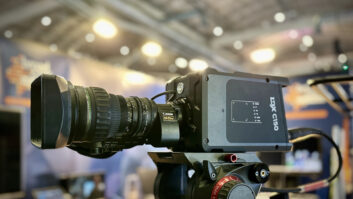
Stereo 3D production accessories were the rule not the exception at NAB. Among them were solutions for easing subtitle placement; a first 3D prompting monitor; and a handy means of handling dual streams in post without doubling storage space. NAB 2011 revealed the virtual ubiquity of stereo 3D with product capable of acquiring, recording, managing, manipulating, delivering or viewing 3D in some fashion seen everywhere. While there is an extensive round-up of imaging systems in TVB Europe’s NAB wrap issue, here’s a round-up of some additional accessories. Screen Subtitling Systems (www.subtitling.com) demonstrated a new depth mapping module for its 3D subtitling product, 3DITOR. The company believes manual placement and ensuring that subtitles are not ‘bumping’ in to any other objects can prove laborious and be prone to oversight. Its disparity mapping module takes away that guesswork and helps eliminate human error. By producing a real-time, 3D pin-graph or graphical interpretation of each scene, the new module makes it possible to see where the subtitle is placed within the image and whether it is encroaching on the space of any other objects. Bright Technologies (www.4bright.com) showcased its 3D Stereoscopic Optimizer which, in tandem with Bright’s media servers, enables smaller post facilities to take on 3D projects without having to dramatically increase their hardware commitments.
Since stereo projects typically entail a doubling of the data volume through a facility Bright’s innovation merges 3D frames for playback in one continuous stream. “As the movie and TV industry turns more towards 3D content, Bright has responded with a technology that facilitates the handling and management of 3D interleaved projects,” said Bright president Ed Rodriguez, President. “This makes 3D workflows easier to manage in terms of data wrangling and storage performance, and ensures that hardware costs are kept to a minimum as operators do not need to work on two volumes or name spaces.” Video processor vendor Teranex Systems (www.teranex.com) introduced a 3D software application meant to help correct for typical problems created by 3D rigs. The VC1-3DTK runs on Teranex’s dual channel VC100s and can flip the right or left eye horizontally and vertically, adjust for IA distance with separate horizontal and vertical adjustments and change the axial and toe-in rotation angles, zoom or crop and adjust all video parameters for accurate R eye L eye matching. “Capturing effective 3D with high quality cameras can be expensive and quite a challenge for stereographers so this new application allows them more flexibility,” says Ray Conkling, assistant general manager at Teranex. “They can use any camera pair to achieve the best 3D. Our 3DTK and 3D Sync applications resolve any gen-lock, geometric or electronic disparity issue. “We were intrinsically involved in the SD to HD transition, and we believe our exceptional technology will do the same for 3D production, by helping to provide more affordable means to create more 3D content.”
Dashwood Cinema Solutions (www.Dashwood3D.com) presented the Stereo3D CAT suite of visual aides for on-location calibration and analysis (second Dashwood image at top of page). The Mac-based software’s includes an Alignment Tracker, a Stereo3D Visualizer, and a Parallax Inspector to calculate the correct camera alignment points, illustrate the depth of the 3D scene and avoid divergence. It is available in the autumn. “We can now calibrate, perform the necessary stereoscopic calculations, and check that everything is within safe parallax limits … and we can do it faster than ever before. No more waiting to go into post to see if the shot looks good — stereographers can analyze it on the spot and make adjustments with certainty throughout the entire shoot,” says company founder Tim Dashwood. Another suite of stereoscopic analysis tools is available from Cambridge-based Cel-Soft (www.cel-soft.com) which made NAB the venue to launch the latest version of Cel-Scope3D for automatic QC on-set or in post. A new logging option charts against timecode the maximum and minimum depth values employed, together with the range in use. Measurements can be viewed either in percentage of screen width or in horizontal pixels. A cursor can be placed on any object of interest or point of attention for an instant measurement of that spot’s disparity and hence depth. The display chart can be shared electronically or on paper with other members of the production team. Available as a complete system or as Windows-compatible software the Cel-Scope3D can also run on a laptop. Even prompting specialist Autoscript (www.autoscript.tv) has prepared a monitor for use on a 3D rig. Not displayed at NAB but on offer should broadcasters request it, the 3D unit has been optimized for use on 3Ality rigs. “While the live sports production maybe in 3D the links back to studio are still 2D,” said managing director Brian Larter. “It’s logical to address this with a monitoring system balanced so that it doesn’t throw the cameras off alignment and we are the first prompting company to do so.” Vinten (www.Vinten.com) launched a 3D wedge adapter for balancing rigs which cannot be mounted to a conventional head in a balanced position. Demonstrated with a Vector 950 system set up with a Stereotec beamsplitter, the adapter, says product manager Peter Harman, “is designed to facilitate the proper balancing of under/through beamsplitter 3D rigs and allows more clearance for the under-slung camera, which increases the downward tilt available.”
Rohde & Schwarz owned DVS (www.dvs.de) presented its VENICE video server featuring new functions for 3D ingest and 3D playout for live stereo workflows. It was shown running the STAN (stereoscopic analyzer) software from the Fraunhofer Heinrich-Hertz Institute which analyzes and corrects parameters such as geometry, camera distance and the stereo baseline in realtime while the VENICE manages the record and playout of stereoscopic material.Stereo 3D production accessories were the rule not the exception at NAB. Among them were solutions for easing subtitle placement; a first 3D prompting monitor; and a handy means of handling dual streams in post without doubling storage space. NAB 2011 revealed the virtual ubiquity of stereo 3D with product capable of acquiring, recording, managing, manipulating, delivering or viewing 3D in some fashion seen everywhere. While there is an extensive round-up of imaging systems in TVB Europe’s NAB wrap issue, here’s a round-up of some additional accessories. Screen Subtitling Systems (www.subtitling.com) demonstrated a new depth mapping module for its 3D subtitling product, 3DITOR. The company believes manual placement and ensuring that subtitles are not ‘bumping’ in to any other objects can prove laborious and be prone to oversight. Its disparity mapping module takes away that guesswork and helps eliminate human error. By producing a real-time, 3D pin-graph or graphical interpretation of each scene, the new module makes it possible to see where the subtitle is placed within the image and whether it is encroaching on the space of any other objects. Bright Technologies (www.4bright.com) showcased its 3D Stereoscopic Optimizer which, in tandem with Bright’s media servers, enables smaller post facilities to take on 3D projects without having to dramatically increase their hardware commitments.
Since stereo projects typically entail a doubling of the data volume through a facility Bright’s innovation merges 3D frames for playback in one continuous stream. “As the movie and TV industry turns more towards 3D content, Bright has responded with a technology that facilitates the handling and management of 3D interleaved projects,” said Bright president Ed Rodriguez, President. “This makes 3D workflows easier to manage in terms of data wrangling and storage performance, and ensures that hardware costs are kept to a minimum as operators do not need to work on two volumes or name spaces.” Video processor vendor Teranex Systems (www.teranex.com) introduced a 3D software application meant to help correct for typical problems created by 3D rigs. The VC1-3DTK runs on Teranex’s dual channel VC100s and can flip the right or left eye horizontally and vertically, adjust for IA distance with separate horizontal and vertical adjustments and change the axial and toe-in rotation angles, zoom or crop and adjust all video parameters for accurate R eye L eye matching. “Capturing effective 3D with high quality cameras can be expensive and quite a challenge for stereographers so this new application allows them more flexibility,” says Ray Conkling, assistant general manager at Teranex. “They can use any camera pair to achieve the best 3D. Our 3DTK and 3D Sync applications resolve any gen-lock, geometric or electronic disparity issue. “We were intrinsically involved in the SD to HD transition, and we believe our exceptional technology will do the same for 3D production, by helping to provide more affordable means to create more 3D content.”
Dashwood Cinema Solutions (www.Dashwood3D.com) presented the Stereo3D CAT suite of visual aides for on-location calibration and analysis (second Dashwood image at top of page). The Mac-based software’s includes an Alignment Tracker, a Stereo3D Visualizer, and a Parallax Inspector to calculate the correct camera alignment points, illustrate the depth of the 3D scene and avoid divergence. It is available in the autumn. “We can now calibrate, perform the necessary stereoscopic calculations, and check that everything is within safe parallax limits … and we can do it faster than ever before. No more waiting to go into post to see if the shot looks good — stereographers can analyze it on the spot and make adjustments with certainty throughout the entire shoot,” says company founder Tim Dashwood. Another suite of stereoscopic analysis tools is available from Cambridge-based Cel-Soft (www.cel-soft.com) which made NAB the venue to launch the latest version of Cel-Scope3D for automatic QC on-set or in post. A new logging option charts against timecode the maximum and minimum depth values employed, together with the range in use. Measurements can be viewed either in percentage of screen width or in horizontal pixels. A cursor can be placed on any object of interest or point of attention for an instant measurement of that spot’s disparity and hence depth. The display chart can be shared electronically or on paper with other members of the production team. Available as a complete system or as Windows-compatible software the Cel-Scope3D can also run on a laptop. Even prompting specialist Autoscript (www.autoscript.tv) has prepared a monitor for use on a 3D rig. Not displayed at NAB but on offer should broadcasters request it, the 3D unit has been optimized for use on 3Ality rigs. “While the live sports production maybe in 3D the links back to studio are still 2D,” said managing director Brian Larter. “It’s logical to address this with a monitoring system balanced so that it doesn’t throw the cameras off alignment and we are the first prompting company to do so.” Vinten (www.Vinten.com) launched a 3D wedge adapter for balancing rigs which cannot be mounted to a conventional head in a balanced position. Demonstrated with a Vector 950 system set up with a Stereotec beamsplitter, the adapter, says product manager Peter Harman, “is designed to facilitate the proper balancing of under/through beamsplitter 3D rigs and allows more clearance for the under-slung camera, which increases the downward tilt available.”
Rohde & Schwarz owned DVS (www.dvs.de) presented its VENICE video server featuring new functions for 3D ingest and 3D playout for live stereo workflows. It was shown running the STAN (stereoscopic analyzer) software from the Fraunhofer Heinrich-Hertz Institute which analyzes and corrects parameters such as geometry, camera distance and the stereo baseline in realtime while the VENICE manages the record and playout of stereoscopic material.






